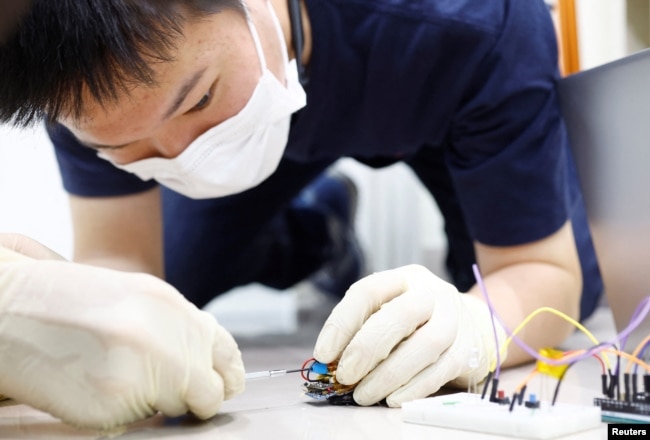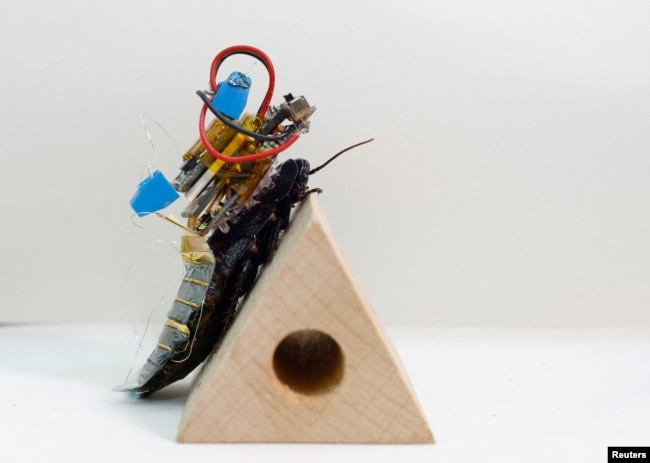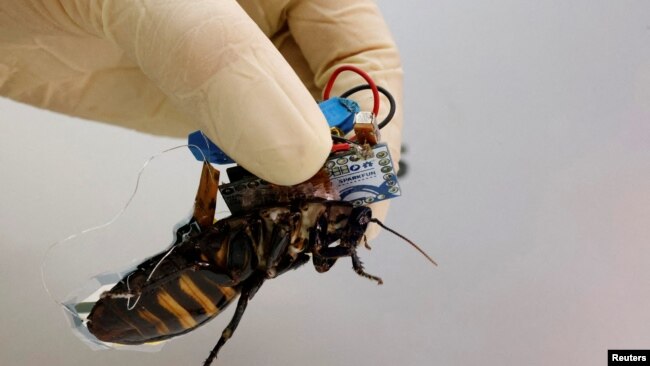Oh!!コックローチ様!!
思わず、コーヒーを吹き出しそうになったタイトル!!ごめんなさい!!
コックローチ様にその様な崇高な使命を与えようとは・・・
(健康チェックは私はパス。)
今日10月3日からノーベル賞2022の発表です。栄冠は誰の手に!!
VOAで英語を学びましょう!!
日本の研究者がゴキブリの遠隔操作を作成(和訳)
Japanese Researchers Create Remote Control for Cockroaches
October 02, 2022
たいていの場合、人はゴキブリを見ると、嫌な気持ちになります。この虫は世界中に害虫として知られています – つまり人に迷惑をかける生き物として。
しかし、ゴキブリは研究科学者にとって有用な昆虫です。そして、いつか大地震の後の生存者探しに使われるかもしれないのです。
日本の科学者たちは、この昆虫に取り付けて遠隔操作remote control.を可能にするシステムを研究し続けてきました。
ケンジロー・フクダ氏が理研、科学研究をする会社、で薄膜デバイス研究所のチームを率いています。このチームがゴキブリの体に貼り付けることができる薄い太陽電池を作りました。それは髪の毛よりも細いものです。
この太陽電池は、ゴキブリが自由に動くことを許しますが、昆虫の足を制御する器官に信号を送ります。
科学者たちは、遠距離からゴキブリを制御できると考えています。つまり、地震で倒壊した建物などの被災地に昆虫を送り込むことができるようになるのです。小さな昆虫は、人間やレスキューロボットでさえ到達できないような場所に入り込むことができます。適切な設備があれば、壊れた建物の下敷きになった生存者を見つけるのにも使えるかもしれません。
この研究は、シンガポールの科学者たちによって行われたプロジェクトを発展させたものです。
フクダ氏は、レスキューロボットの問題は、バッテリーがすぐに切れてしまうことだと言います。しかし、この昆虫は自分自身で動きます。電池はゴキブリを動かすための信号を送るだけなので、ずっと長持ちするのです。
レスキューロボットに比べれば、”必要な電力もはるかに少なくて済む”とフクダ氏は言います。
研究チームは、マダガスカル産のヒシゴキブリを使っています。このゴキブリは、機材を運ぶのに十分な大きさがあり、倒れても立ち上がることができるほど丈夫なのです。
研究は順調に進んでいますが、まだ実戦で使えるレベルではありません。例えば、最近行われたデモンストレーションでは、ゴキブリに信号を送り、左へ移動させるようにしました。しかし、右へ動けという信号を送ると、ゴキブリは円を描くように動いたのです。
次のステップは、ゴキブリの背中に設置できる小型のカメラやセンサーがあるかどうかということです。研究チームは、東京の家電量販店でわずか35ドルで購入した材料を使って、最初のテスト用バックパックを作成しました。
この薄い太陽電池が救助活動に使えないとしても、将来的にはさまざまな用途が考えられるとフクダ氏は言います。
例えば、衣服の中に入れて、その人の健康状態を測定することができます。また、傘の中に入れてもいいでしょう。この方法を使って、携帯電話を充電するのに必要な電力を作ることができるでしょう。
Japanese Researchers Create Remote Control for Cockroaches
Most of the time, people are not happy to see cockroaches. The insect is known around the world as a pest – a creature that causes problems for people.
However, the cockroach is a useful insect for research scientists. And they could one day be used to help find survivors after major earthquakes.
Scientists in Japan have been working on a system that they can attach to the insects that permits remote control.
Kenjiro Fukuda leads a team at the Thin-Film Device Laboratory at Riken, a company that does scientific research. The team created a thin solar cell they can attach to the body of a cockroach. It is thinner than a human hair.
The cell permits the cockroach to move freely but it sends signals to organs that control the insect’s legs.
The scientists believe they can control the cockroaches from a long distance. This means they will be able to send the insects into a disaster area, such as a building destroyed by an earthquake. The small insects can get into places that humans and even rescue robots cannot reach. With the right equipment, they could be used to help find survivors stuck under broken pieces of buildings.
The work advances a project done by scientists in Singapore.
Fukoda said the problem with rescue robots is their batteries run out quickly. The insect, however, moves on its own. The battery only sends a signal that makes the cockroach move, so it lasts much longer.
“The electricity required is nowhere near as much” as what is required for rescue robots, Fukoda said.
The research team is using hissing cockroaches from Madagascar. Those cockroaches are big enough to carry the equipment and strong enough to get back on their feet if they fall over.
Although the research is going well so far, the technology is not fully ready for use in the real world. For example, in a recent demonstration, the scientists sent signals to a cockroach that caused it to move to the left. However, the cockroach moved in circles when they sent a signal telling it to move right.
The next step is to see if there are small cameras and sensors that can be placed on the cockroach’s back. The team created the first test backpack using material purchased from an electronics market in Tokyo for only $35.
Even if the thin solar cell is not able to be used in rescue missions, Fukoda said there could be a number of future uses.
For example, the cells could be used in clothing to measure a person’s health. The cells could also be added to an umbrella. Used in this way, the cells could help generate enough power to charge a mobile phone.
Words in This Story
remote –adj. far away or distant
umbrella –n. an item you hold that protects you from the rain and sun


